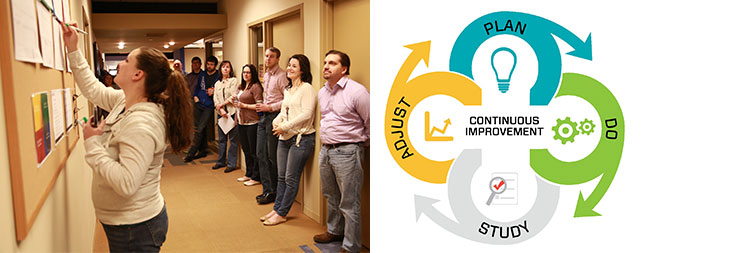Every day at Array we strive to improve our delivery process so our customers can receive the best quality product we can produce. Plan-Do-Study-Adjust (PDSA) is a process improvement tool that aids in the creation of better processes. Using Karen Martin’s clarified version of the PDSA found in The Outstanding Organization, employees at Array are tackling problems, determining root causes, developing solutions and periodically reviewing the outcomes to ensure that these issues do not surface again. Here is Array’s take on these four steps:

PLAN-Develop Hypothesis
The planning phase is the most rigorous and time consuming. It is also the most important. If the planning phase is not carried out to its fullest, the subsequent phases will not produce the expected results. During planning, the problem is explicitly stated and the current state is defined. After defining a current state, the future state is idealized and root causes are explored. Identifying root causes provides concrete reasons explaining why the problem exists. Sometimes the flow of the meeting results in a slightly different order, but we always ensure that every part of the planning phase is thoroughly explored.
DO-Conduct Experiment
In the do phase of PDSA, countermeasures are developed to address the root causes found in the previous step. Effective countermeasures relate directly to the problem at hand and can be easily executed by a test group. Once there is consensus around the proper countermeasures, an implementation plan can be developed and carried out. Typically, the implementation is first performed by the problem solving team.
STUDY-Evaluate Results
The study phase is exciting because the problem solvers on the team get to experience the effects of their countermeasures first hand. Typically, this phase is largely made up of data collection and user feedback. The results collected from the study phase drive the next part of the PDSA cycle. While this phase seems simple, it is the one that leads to data-driven results that form the foundation of meaningful change.
ADJUST-Refine, Standardize, Stabilize
At Array, we interpret the adjust phase in a number of different ways. Sometimes, the solution that is being evaluated works perfectly and can be adopted by all users who will be affected by the change. In this case, the implementation plan used in the study phase is rolled out, and the change becomes a standard for all users. Other times, the solution needs a little tweaking, resulting in a new cycle of PDSA. In either situation, this phase is always used as a reminder to re-visit a previously completed project. The re-evaluation helps determine if the benefits of the change are still being realized and opens the door for future improvements. If there is a need for changes at this time, the PDSA cycle begins again, leading to an even better solution.
Continuous Improvement is a daily mantra at Array, inside and outside our walls. Want more insight to how we are changing on the inside? Read this recent blog by our Continuous Improvement Practice Area Leader, Jonathan Bykowski.
Wanting more from Laura Silvoy? Read her blogs!

